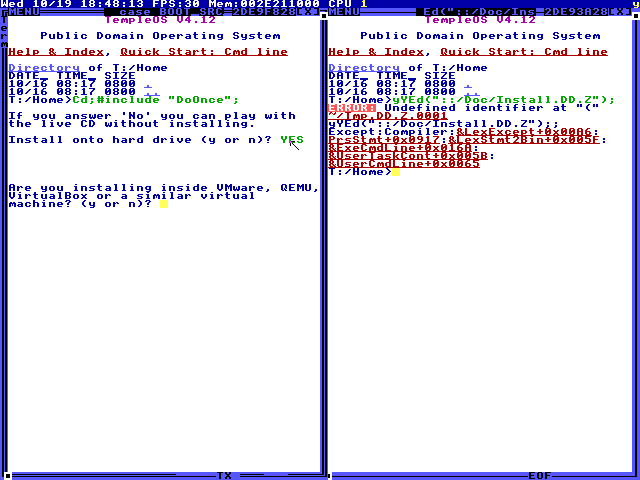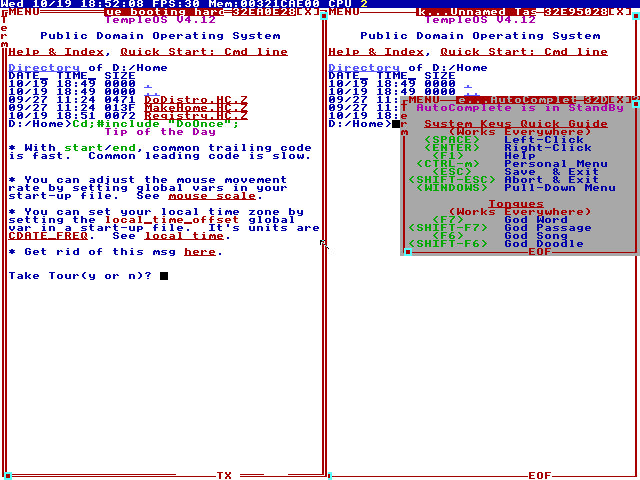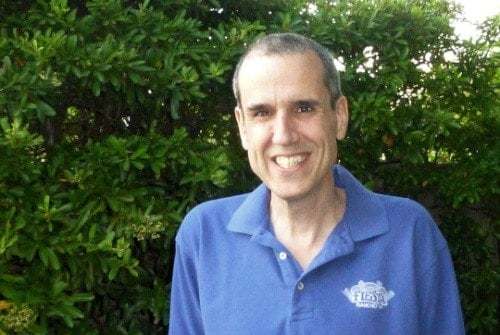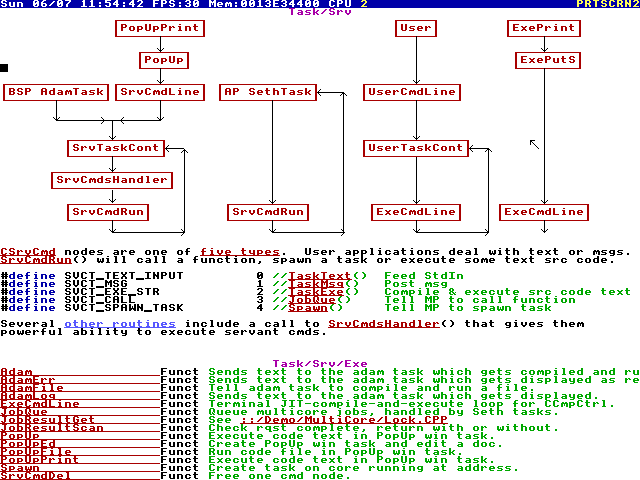TempleOS: a biblical operating system written by schizophrenic
The OS distribution is tiny - only 17 megabytes. It can be quickly downloaded and tested.
The target platform is x86-64. It is unlikely that someone will experiment with a similar one as an actually installed OS, so we will need any virtual machine, for example, VirtualBox or QEMU. The creator himself uses commercial VMware Workstation. Set at least half a gigabyte of memory for the virtual machine.

')
From the downloaded image, you can simply boot and work in LiveCD mode or install the system on a disk. Installing TempleOS is no more difficult than installing any modern operating system. You only need to press the

The resulting vaguely resembles something from the Commodore 64. However, the creator himself describes his work as a modern x86_64 Commodore 64 with C instead of BASIC. So what have we just installed?

 The man on the left is Terry Davis. God chose him to create a temple operating system. Davis wrote the kernel, 64-bit compiler and the operating system itself - an oracle to communicate with God.
The man on the left is Terry Davis. God chose him to create a temple operating system. Davis wrote the kernel, 64-bit compiler and the operating system itself - an oracle to communicate with God.
On all the resources where Davis is present, he mixes up clear and logical phrases with delusions about the CIA's machinations, demonstrates hatred towards Jews and black people. This is probably some form of coprolalia . For regular flashes of such sayings, he was banned in many forums, for example, on Hacker News .
A typical example of his opponents, and in general all the people who do not like him, Davis calls politically correct niggers.
Terry Davis was born in December 1969 in the family of an industrial engineer. In a large family, he was the seventh of eight children. The family often moved from place to place: Terry grew up in Wisconsin, Washington, Michigan, California and Arizona. With Apple II, he met in elementary school in the program for gifted children, in the early eighties, he learned the language of the assembler Commodore 64. Write the code Davis began back in school.
By 1994, he first received a bachelor’s degree, then a master’s degree in electrical engineering from the University of Arizona. For a while, Davis lived in the city of Tempe, where he had a job. As a student in 1990, he began writing operating system components for the ticket seller Ticketmaster. In 1993, Davis had a machine with a 486 processor. On it, he wrote a DOS protected mode application that never returned control. Terry has set up a keyboard for displaying characters on the screen and basic multitasking. In fact, it was the germ of a future OS.
The former student liked working at Ticketmaster less and less: the company transferred him to uninteresting research projects. Terry Davis, 26, wanted to write satellite management systems and was thinking about changing jobs. In early 1996, he sent his resume to several defense companies.
Further description of the life of Terry is difficult to perceive. In the middle of March of the same year, he began to notice that he was being watched. Is this a check for one of these companies where he asked for a job? There were quantum computers and conspiracy theories in Davis's head. He drove out of the city to the south and listened to the radio, and the radio answered him. In the city of Marfa (Texas), he stopped and remembered the fact that oil companies are suppressing the development of engines on the water. He searched the car for bugs and threw away the keys in the desert.
This was followed by police arrest, escape, broken collarbone, hospital, escape due to “artifacts” on X-rays (aliens must have planted), an attempt to steal a pickup truck, a prison and two weeks in a psychiatric hospital. After this, Davis tried to repeat the path of Christ and distributed his possessions. Since 1996, Davis has ceased to be an atheist and is constantly looking for ways to God.
In July 1996, Davis's mental state improved, he returned to Arizona. There he tried to create a three-axis milling machine - even then it was clear that there was a future for 3D printers. A power tool fire almost caused a fire, and Terry abandoned the idea.

Prototype machine.
This was followed by a move back to his parents' house — Davis wanted to save some money while writing the continuation of Orwell’s 1984 novel. The sequel never worked.
From 1996 to 2003, about every six months, a new manic episode occurred. At first, doctors believed that Davis had bipolar disorder , but later diagnosed " schizophrenia ." Since 2003, Davis's mental health has been managed with medication. Strong attacks do not happen, although the oddities in behavior remained.
Since 2003, the era of the x86-64 architecture has begun. AMD released Opteron , the first line of microprocessors that could extend 64-bit calculations by extending the architecture and address more than 4 GB of memory. And here Davis saw what technology he needed to use for his digital oracle. He got the old code of experiments in DOS and started working.
Terry has been writing his operating system in its current form since 2003, already 13 years old. Rather, he builds the church of God in scope comparable to Solomon . According to the author , God said to create a temple with a resolution of 640 × 480 pixels in 16 colors. Scanty palette and low resolution help to avoid the need to write graphics drivers for hardware acceleration. The Lord told Davis that the sound needed one voice with different waveforms. God also asked the temple to be perfect, so Davis made the OS simple. During the development period, the system changed many names: Doors, Davos, J, LoseThos, SparrowOS. In 2013, the current name TempleOS appeared.
Davis explains the TempleOS device.
Technically, TempleOS is a multi-tasking multi-core operating system. There are no separate flows - it is just the same as processes.
TempleOS started as an abandoned 1993 project for DOS, but was brought to the level of an independent OS. Gradually, Davis wrote his own loader, the need to boot into FreeDOS disappeared. OS itself did not start as a temple, the author came with time.
Source codes are open and free as public domain. In the OS, there is essentially no support for the network or any devices at all. It has a basic minimum for what is called an OS. All applications run in ring 0 , with the highest priority, without memory protection. There is no paging of pages - so the operating system loads as quickly, in a second. It is immediately available for use.
The system has a command line interface that is implemented in an original way. Davis could not remember the bash commands, but he knew the C / C ++ syntax well. Therefore, scripts are written in C, or rather, its modifications. For his operating system, Davis changed the standard C and called it received HolyC ("holy si").

Comics in the assembly system.
Except for the low levels, where there is a 64-bit assembler language, the whole system is written in this HolyC. It is different from the usual. No
The system reminds that it is a digital oracle. Previously, Davis tossed a coin and chose a random number to open the Bible, read the fragment and interpret it. In TempleOS anywhere, pressing F7 will bring a random word. If you press F7 several times, you get a piece of text in which you can search for meaning. Shift + F7 will display a fragment of the Bible.
Throughout the system there are auto-completion hints, which are available by Ctrl + F1. All sources are indexed. Shell is a hypertext document of the developed DolDoc format. It embeds images, sprites (including three-dimensional) and macro. In the system everywhere you can open the editor of sprites and paste them into any document. The documents themselves are stored.

Clicking the rectangles will open the source file referenced.
The file system Red Sea is unique. As the author says, it was necessary to do something that would not threaten the court. The file manager is called by Ctrl + D, although if desired, the user can do without it by entering the contents command of the current
The system has several applications written by the author. Because of the differences in the language of the application, you need to rewrite, and not just port. Probably, Davis will remain the only person who writes under TempleOS. So far, only one case is known when another developer has shown interest in the platform. But even this enthusiast looked at TempleOS as an alien computer .
By generating pseudo-random numbers, AfterEgypt allows you to communicate with God. It is only necessary to find a burning thorn bush. The application describes the time interval after Moses left Egypt.
Flight simulator and first-person shooter. In the latter, the influence of Wolftenstein is noticeable.
Application for writing music.
Davis continues to develop. He regularly broadcasts videos on YouTube and releases new versions of his OSes.
You can laugh and poke a finger, considering Davis to be useless crazy with an unnecessary OS. On the other hand, even if you do not close your eyes to the religiousness of the project, this is an interesting research paper. It has its own characteristics and, perhaps, convenience. The document approach is reminiscent of Xerox Alto , Oberon and Plan 9 . At TempleOS, the possibilities of modern computers and the principles of the Apple II and Commodore 64 era strangely border.
The target platform is x86-64. It is unlikely that someone will experiment with a similar one as an actually installed OS, so we will need any virtual machine, for example, VirtualBox or QEMU. The creator himself uses commercial VMware Workstation. Set at least half a gigabyte of memory for the virtual machine.

')
From the downloaded image, you can simply boot and work in LiveCD mode or install the system on a disk. Installing TempleOS is no more difficult than installing any modern operating system. You only need to press the
y key several times and wait for the files to be copied.
The resulting vaguely resembles something from the Commodore 64. However, the creator himself describes his work as a modern x86_64 Commodore 64 with C instead of BASIC. So what have we just installed?

Terry Davis
 The man on the left is Terry Davis. God chose him to create a temple operating system. Davis wrote the kernel, 64-bit compiler and the operating system itself - an oracle to communicate with God.
The man on the left is Terry Davis. God chose him to create a temple operating system. Davis wrote the kernel, 64-bit compiler and the operating system itself - an oracle to communicate with God.On all the resources where Davis is present, he mixes up clear and logical phrases with delusions about the CIA's machinations, demonstrates hatred towards Jews and black people. This is probably some form of coprolalia . For regular flashes of such sayings, he was banned in many forums, for example, on Hacker News .
A typical example of his opponents, and in general all the people who do not like him, Davis calls politically correct niggers.
Terry Davis was born in December 1969 in the family of an industrial engineer. In a large family, he was the seventh of eight children. The family often moved from place to place: Terry grew up in Wisconsin, Washington, Michigan, California and Arizona. With Apple II, he met in elementary school in the program for gifted children, in the early eighties, he learned the language of the assembler Commodore 64. Write the code Davis began back in school.
By 1994, he first received a bachelor’s degree, then a master’s degree in electrical engineering from the University of Arizona. For a while, Davis lived in the city of Tempe, where he had a job. As a student in 1990, he began writing operating system components for the ticket seller Ticketmaster. In 1993, Davis had a machine with a 486 processor. On it, he wrote a DOS protected mode application that never returned control. Terry has set up a keyboard for displaying characters on the screen and basic multitasking. In fact, it was the germ of a future OS.
The former student liked working at Ticketmaster less and less: the company transferred him to uninteresting research projects. Terry Davis, 26, wanted to write satellite management systems and was thinking about changing jobs. In early 1996, he sent his resume to several defense companies.
Further description of the life of Terry is difficult to perceive. In the middle of March of the same year, he began to notice that he was being watched. Is this a check for one of these companies where he asked for a job? There were quantum computers and conspiracy theories in Davis's head. He drove out of the city to the south and listened to the radio, and the radio answered him. In the city of Marfa (Texas), he stopped and remembered the fact that oil companies are suppressing the development of engines on the water. He searched the car for bugs and threw away the keys in the desert.
This was followed by police arrest, escape, broken collarbone, hospital, escape due to “artifacts” on X-rays (aliens must have planted), an attempt to steal a pickup truck, a prison and two weeks in a psychiatric hospital. After this, Davis tried to repeat the path of Christ and distributed his possessions. Since 1996, Davis has ceased to be an atheist and is constantly looking for ways to God.
In July 1996, Davis's mental state improved, he returned to Arizona. There he tried to create a three-axis milling machine - even then it was clear that there was a future for 3D printers. A power tool fire almost caused a fire, and Terry abandoned the idea.

Prototype machine.
This was followed by a move back to his parents' house — Davis wanted to save some money while writing the continuation of Orwell’s 1984 novel. The sequel never worked.
From 1996 to 2003, about every six months, a new manic episode occurred. At first, doctors believed that Davis had bipolar disorder , but later diagnosed " schizophrenia ." Since 2003, Davis's mental health has been managed with medication. Strong attacks do not happen, although the oddities in behavior remained.
Since 2003, the era of the x86-64 architecture has begun. AMD released Opteron , the first line of microprocessors that could extend 64-bit calculations by extending the architecture and address more than 4 GB of memory. And here Davis saw what technology he needed to use for his digital oracle. He got the old code of experiments in DOS and started working.
TempleOS
Terry has been writing his operating system in its current form since 2003, already 13 years old. Rather, he builds the church of God in scope comparable to Solomon . According to the author , God said to create a temple with a resolution of 640 × 480 pixels in 16 colors. Scanty palette and low resolution help to avoid the need to write graphics drivers for hardware acceleration. The Lord told Davis that the sound needed one voice with different waveforms. God also asked the temple to be perfect, so Davis made the OS simple. During the development period, the system changed many names: Doors, Davos, J, LoseThos, SparrowOS. In 2013, the current name TempleOS appeared.
Davis explains the TempleOS device.
Technically, TempleOS is a multi-tasking multi-core operating system. There are no separate flows - it is just the same as processes.
TempleOS started as an abandoned 1993 project for DOS, but was brought to the level of an independent OS. Gradually, Davis wrote his own loader, the need to boot into FreeDOS disappeared. OS itself did not start as a temple, the author came with time.
Source codes are open and free as public domain. In the OS, there is essentially no support for the network or any devices at all. It has a basic minimum for what is called an OS. All applications run in ring 0 , with the highest priority, without memory protection. There is no paging of pages - so the operating system loads as quickly, in a second. It is immediately available for use.
The system has a command line interface that is implemented in an original way. Davis could not remember the bash commands, but he knew the C / C ++ syntax well. Therefore, scripts are written in C, or rather, its modifications. For his operating system, Davis changed the standard C and called it received HolyC ("holy si").

Comics in the assembly system.
Except for the low levels, where there is a 64-bit assembler language, the whole system is written in this HolyC. It is different from the usual. No
main() , everything that is written is executed. All TempleOS code is JIT compiled on request. If you type #include from the command line, then the specified program will be launched in the shell namespace.The system reminds that it is a digital oracle. Previously, Davis tossed a coin and chose a random number to open the Bible, read the fragment and interpret it. In TempleOS anywhere, pressing F7 will bring a random word. If you press F7 several times, you get a piece of text in which you can search for meaning. Shift + F7 will display a fragment of the Bible.
Throughout the system there are auto-completion hints, which are available by Ctrl + F1. All sources are indexed. Shell is a hypertext document of the developed DolDoc format. It embeds images, sprites (including three-dimensional) and macro. In the system everywhere you can open the editor of sprites and paste them into any document. The documents themselves are stored.

Clicking the rectangles will open the source file referenced.
The file system Red Sea is unique. As the author says, it was necessary to do something that would not threaten the court. The file manager is called by Ctrl + D, although if desired, the user can do without it by entering the contents command of the current
Dir; directory Dir; and following the file hyperlinks. File access protection is not expected - only one user.The system has several applications written by the author. Because of the differences in the language of the application, you need to rewrite, and not just port. Probably, Davis will remain the only person who writes under TempleOS. So far, only one case is known when another developer has shown interest in the platform. But even this enthusiast looked at TempleOS as an alien computer .
By generating pseudo-random numbers, AfterEgypt allows you to communicate with God. It is only necessary to find a burning thorn bush. The application describes the time interval after Moses left Egypt.
Flight simulator and first-person shooter. In the latter, the influence of Wolftenstein is noticeable.
Application for writing music.
Davis continues to develop. He regularly broadcasts videos on YouTube and releases new versions of his OSes.
You can laugh and poke a finger, considering Davis to be useless crazy with an unnecessary OS. On the other hand, even if you do not close your eyes to the religiousness of the project, this is an interesting research paper. It has its own characteristics and, perhaps, convenience. The document approach is reminiscent of Xerox Alto , Oberon and Plan 9 . At TempleOS, the possibilities of modern computers and the principles of the Apple II and Commodore 64 era strangely border.
Source: https://habr.com/ru/post/372791/
All Articles